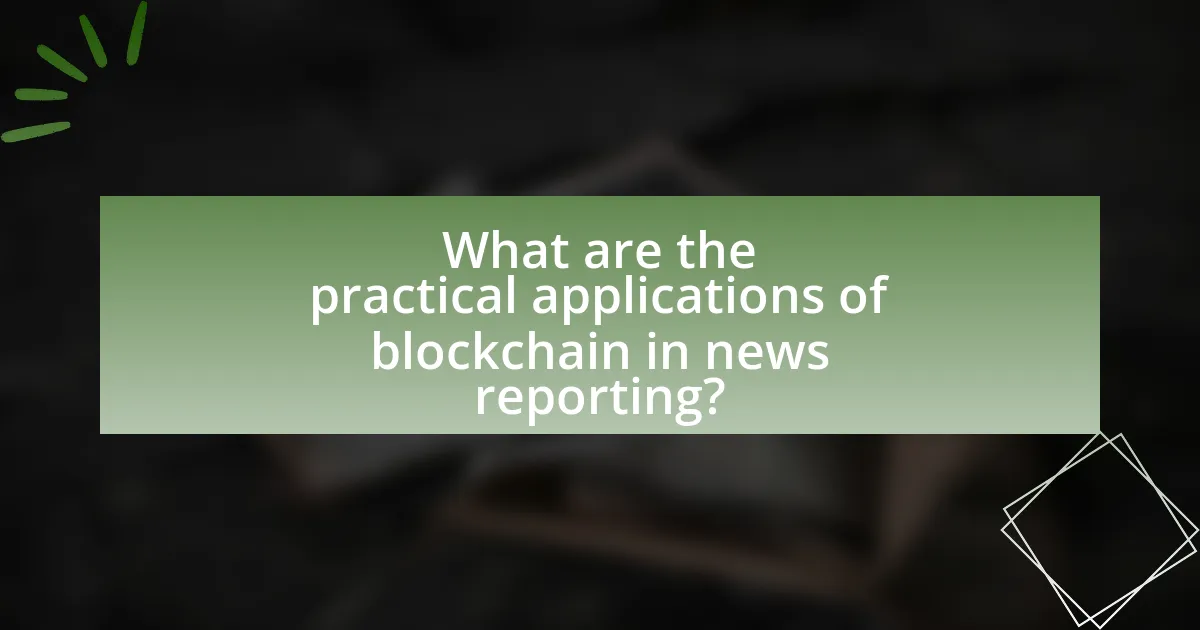Blockchain technology is significantly enhancing transparency in news reporting by providing a decentralized and immutable system for recording information. This technology ensures that news articles cannot be altered after publication, allowing for verifiable authenticity and traceability of sources. Key features such as immutability, decentralization, and traceability foster trust and accountability in journalism, while platforms like Civil exemplify practical applications by enabling direct compensation for journalists and combating misinformation. The article explores the implications of blockchain on media integrity, the challenges faced by news organizations in its implementation, and future trends that may shape the industry.

How is Blockchain Technology Transforming News Reporting?
Blockchain technology is transforming news reporting by enhancing transparency and trust in the dissemination of information. This decentralized ledger system allows for the secure and immutable recording of news articles, ensuring that the original content cannot be altered or tampered with after publication. For instance, platforms like Civil utilize blockchain to verify the authenticity of news sources and articles, providing readers with a transparent history of content creation. Additionally, blockchain enables journalists to receive direct compensation for their work through smart contracts, reducing reliance on traditional advertising models and potentially increasing the quality of reporting. This shift not only empowers journalists but also fosters a more accountable media landscape, as readers can trace the origins and modifications of news stories.
What are the key features of blockchain technology that enhance transparency?
The key features of blockchain technology that enhance transparency include immutability, decentralization, and traceability. Immutability ensures that once data is recorded on the blockchain, it cannot be altered or deleted, providing a permanent and verifiable record of transactions. Decentralization distributes control across a network of nodes, reducing the risk of manipulation by a single entity and allowing all participants to access the same information. Traceability allows users to track the history of transactions, making it easier to verify the authenticity of data. These features collectively foster trust and accountability in systems, such as news reporting, where accurate information is crucial.
How does decentralization contribute to trust in news reporting?
Decentralization contributes to trust in news reporting by enabling a transparent and verifiable system for information dissemination. In a decentralized model, news is not controlled by a single entity, reducing the risk of bias and manipulation. This structure allows multiple sources to validate information independently, fostering accountability. For instance, blockchain technology can record every transaction or piece of information in an immutable ledger, ensuring that the origins and changes to news content are traceable. Studies have shown that decentralized platforms can enhance user trust by providing clear audit trails, as seen in projects like Civil, which uses blockchain to verify journalistic integrity.
What role does immutability play in verifying news content?
Immutability plays a crucial role in verifying news content by ensuring that once information is recorded on a blockchain, it cannot be altered or deleted. This characteristic of blockchain technology provides a reliable and tamper-proof record of news articles, timestamps, and sources, which enhances accountability and trustworthiness. For instance, a study by the Massachusetts Institute of Technology highlighted that blockchain’s immutable ledger can prevent misinformation by allowing users to trace the origin and modifications of news content, thereby verifying its authenticity.
Why is transparency important in news reporting?
Transparency is important in news reporting because it builds trust between journalists and the audience. When news organizations are transparent about their sources, methods, and potential biases, it allows readers to critically evaluate the information presented. For instance, a 2020 study by the Reuters Institute for the Study of Journalism found that 63% of respondents valued transparency in news reporting as a key factor in their trust in media outlets. This trust is essential for a functioning democracy, as informed citizens rely on accurate and honest reporting to make decisions.
How does transparency affect public trust in media?
Transparency significantly enhances public trust in media by providing clear and verifiable information about sources, funding, and editorial processes. When media organizations openly disclose their methodologies and affiliations, audiences are more likely to perceive them as credible and reliable. Research indicates that 73% of people are more likely to trust news organizations that are transparent about their reporting processes (Edelman Trust Barometer, 2021). This trust is crucial in an era where misinformation is prevalent, as transparency helps to establish accountability and fosters a more informed public.
What are the consequences of a lack of transparency in news reporting?
A lack of transparency in news reporting leads to misinformation and erosion of public trust. When news organizations do not disclose their sources or the methods used to gather information, audiences may question the credibility of the news, resulting in skepticism and disengagement. According to a 2021 Pew Research Center study, 64% of Americans believe that news organizations intentionally mislead the public, highlighting the detrimental impact of opacity on audience perception. Furthermore, the absence of transparency can facilitate the spread of fake news, as unverified information circulates unchecked, contributing to societal polarization and confusion.

What are the practical applications of blockchain in news reporting?
Blockchain technology has practical applications in news reporting primarily through enhancing transparency, verifying sources, and ensuring content integrity. By utilizing blockchain, news organizations can create immutable records of articles and their sources, which helps to combat misinformation and verify the authenticity of news. For instance, platforms like Civil have implemented blockchain to allow journalists to publish content that is timestamped and traceable, ensuring that readers can verify the origin and changes made to the articles. Additionally, blockchain can facilitate micropayments for content, allowing readers to support journalists directly, thus promoting independent reporting. These applications demonstrate how blockchain can significantly improve trust and accountability in the news industry.
How are news organizations currently using blockchain technology?
News organizations are currently using blockchain technology to enhance transparency and verify the authenticity of news content. By employing blockchain, these organizations can create immutable records of articles and their sources, ensuring that information is traceable and credible. For instance, platforms like Civil and Po.et utilize blockchain to establish a decentralized network for journalists, allowing them to publish and monetize their work while maintaining ownership and control over their content. This approach not only combats misinformation but also fosters trust among readers by providing verifiable proof of the news’ origin and integrity.
What examples exist of blockchain-based news platforms?
Examples of blockchain-based news platforms include Civil, which utilizes blockchain to ensure transparency and accountability in journalism, and Steemit, a social media platform that rewards users for content creation and curation through cryptocurrency. These platforms leverage blockchain technology to provide immutable records of news articles and user interactions, enhancing trust in the information shared. Civil, for instance, aims to create a decentralized marketplace for journalism, allowing journalists to publish without censorship while ensuring that readers can verify the authenticity of the news. Steemit incentivizes quality content by allowing users to earn tokens based on the popularity of their posts, promoting a more engaged and transparent community.
How do these platforms ensure the authenticity of news articles?
Platforms ensure the authenticity of news articles by utilizing blockchain technology to create immutable records of content and its provenance. This technology allows for the verification of the source, timestamp, and any modifications made to the article, thereby providing a transparent audit trail. For instance, platforms like Civil and Po.et leverage blockchain to store articles in a decentralized manner, ensuring that once published, the content cannot be altered without a trace. This method significantly reduces the risk of misinformation and enhances trust among readers, as they can independently verify the authenticity of the news through the blockchain ledger.
What challenges do news organizations face when implementing blockchain?
News organizations face several challenges when implementing blockchain technology, including technical complexity, scalability issues, and regulatory compliance. The technical complexity arises from the need for specialized knowledge and skills to integrate blockchain systems into existing infrastructures. Scalability issues are significant as blockchain networks can struggle to handle high volumes of transactions, which is crucial for news organizations that require real-time updates. Additionally, regulatory compliance poses a challenge, as news organizations must navigate varying legal frameworks regarding data privacy and security across different jurisdictions. These challenges can hinder the effective adoption of blockchain in enhancing transparency in news reporting.
What technical barriers exist in adopting blockchain technology?
Technical barriers in adopting blockchain technology include scalability issues, interoperability challenges, and high energy consumption. Scalability refers to the difficulty in processing a large number of transactions quickly; for instance, Bitcoin can handle only about seven transactions per second, which is insufficient for widespread use. Interoperability challenges arise from the lack of standard protocols among different blockchain platforms, making it hard for them to communicate and share data effectively. Additionally, the high energy consumption associated with proof-of-work consensus mechanisms, as evidenced by Bitcoin’s estimated annual energy usage of 77 TWh, raises concerns about sustainability and environmental impact.
How can news organizations overcome resistance to change?
News organizations can overcome resistance to change by fostering a culture of innovation and transparency. Implementing blockchain technology can enhance trust and accountability in reporting, which addresses skepticism among staff and audiences. For instance, a study by the Reuters Institute for the Study of Journalism found that transparency in sourcing and fact-checking can significantly improve audience trust. By actively involving employees in the change process and demonstrating the benefits of new technologies, organizations can reduce resistance and encourage adaptation.

What future trends can we expect in blockchain and news reporting?
Future trends in blockchain and news reporting include increased adoption of decentralized platforms for content verification and enhanced transparency in sourcing. As news organizations seek to combat misinformation, blockchain technology will facilitate immutable records of news articles and their sources, allowing audiences to trace the origin and modifications of information. A study by the Reuters Institute for the Study of Journalism indicates that 63% of journalists believe blockchain can improve trust in news by providing verifiable content. Additionally, smart contracts may automate payment processes for freelance journalists, ensuring fair compensation and timely transactions. These trends highlight a shift towards accountability and trust in the news industry, driven by blockchain’s capabilities.
How might blockchain technology evolve in the news industry?
Blockchain technology may evolve in the news industry by enhancing content verification and improving transparency in reporting. As news organizations adopt blockchain, they can create immutable records of articles, timestamps, and sources, which helps to combat misinformation and establish trust with audiences. For instance, platforms like Civil have already demonstrated how blockchain can be used to verify the authenticity of news stories and the credibility of journalists. This evolution could lead to a more accountable media landscape, where readers can trace the origins of information and verify its accuracy through decentralized ledgers.
What innovations could enhance the transparency of news reporting?
Blockchain technology can significantly enhance the transparency of news reporting by providing a decentralized and immutable ledger for information verification. This innovation allows journalists and news organizations to record the provenance of news articles, ensuring that the source and any modifications are traceable. For instance, a study by the Reuters Institute for the Study of Journalism highlights that blockchain can help combat misinformation by allowing readers to verify the authenticity of news content through a transparent chain of custody. By implementing blockchain, news outlets can foster greater trust with their audience, as the technology inherently reduces the risk of tampering and enhances accountability in reporting.
How will audience engagement change with blockchain integration?
Audience engagement will increase with blockchain integration by providing greater transparency and trust in news reporting. Blockchain technology allows for the verification of sources and the authenticity of information, enabling audiences to trace the origins of news articles and confirm their credibility. This transparency fosters a more informed audience, as studies show that trust in media correlates with higher engagement levels. For instance, a 2021 survey by the Reuters Institute found that 61% of respondents were more likely to engage with news they deemed trustworthy. Thus, blockchain’s ability to enhance transparency directly contributes to improved audience engagement in news reporting.
What best practices should news organizations follow when using blockchain?
News organizations should prioritize transparency, security, and collaboration when using blockchain technology. Transparency can be achieved by ensuring that all content is verifiable on the blockchain, allowing audiences to trace the origin and modifications of news articles. Security is critical; organizations must implement robust encryption methods to protect sensitive data and maintain the integrity of information. Collaboration with other media entities and blockchain developers can foster innovation and create standardized protocols, enhancing the overall effectiveness of blockchain in news reporting. These practices are supported by the increasing adoption of blockchain in various sectors, demonstrating its potential to improve trust and accountability in information dissemination.
How can news organizations educate their audience about blockchain benefits?
News organizations can educate their audience about blockchain benefits by producing informative content that highlights its applications in enhancing transparency and trust in news reporting. For instance, they can create articles, videos, and infographics that explain how blockchain technology can verify the authenticity of news sources and track the provenance of information. Research from the World Economic Forum indicates that blockchain can improve trust in media by providing immutable records of content creation and distribution, thereby reducing misinformation. By leveraging case studies and real-world examples, news organizations can illustrate the practical benefits of blockchain, such as its role in ensuring accountability and fostering a more transparent media landscape.
What strategies can enhance the credibility of blockchain-based news sources?
Implementing decentralized verification processes can significantly enhance the credibility of blockchain-based news sources. By utilizing smart contracts, news articles can be automatically verified against multiple independent sources before publication, ensuring accuracy and reducing the risk of misinformation. Additionally, integrating user feedback mechanisms allows readers to report inaccuracies, which can be transparently tracked and addressed on the blockchain. This approach not only fosters community engagement but also builds trust, as users can see the history of corrections and updates. Furthermore, employing cryptographic signatures for authorship verification ensures that the identity of the news source is authenticated, thereby reinforcing accountability. These strategies collectively contribute to a more reliable and trustworthy news ecosystem, as evidenced by projects like Civil, which leverages blockchain to create a sustainable model for journalism that prioritizes transparency and accountability.




